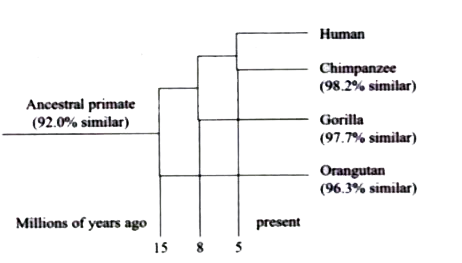Humans are most closely related to _________.
Marsupial
Lemur
Chimpanzees
Tarsier
The correct Answer is:C
Step-by-Step Solution:
1. Understanding the Question: The question asks about the closest relative of humans among a list of options.
2. Analyzing the Options:
- Marsupials: These are mammals that give birth to underdeveloped young, which then continue to develop in a pouch (marsupium). Examples include kangaroos. Humans have a more developed placenta, making marsupials less closely related to humans.
- Lemurs: Lemurs are considered non-primates and do not have a menstrual cycle, which is a characteristic of primates. Therefore, they are not closely related to humans.
- Chimpanzees: Chimpanzees are primates and share a significant amount of genetic material with humans. They have a similar reproductive cycle (menstrual cycle) and their chromosome structure is closely related to that of humans. Research indicates that humans and chimpanzees share about 97% of their DNA.
- Tarsiers: Tarsiers are also classified as non-primates and do not share the same evolutionary lineage as humans.
3. Comparing Genetic Similarity: The genetic comparison shows that chimpanzees have 48 chromosomes, while humans have 46. Despite this difference, the high percentage of DNA similarity indicates a close evolutionary relationship.
4. Conclusion: Based on the analysis, chimpanzees are the closest relatives to humans among the given options.
Final Answer: Humans are most closely related to Chimpanzees.
---
- Marsupials: These are mammals that give birth to underdeveloped young, which then continue to develop in a pouch (marsupium). Examples include kangaroos. Humans have a more developed placenta, making marsupials less closely related to humans.
- Lemurs: Lemurs are considered non-primates and do not have a menstrual cycle, which is a characteristic of primates. Therefore, they are not closely related to humans.
- Chimpanzees: Chimpanzees are primates and share a significant amount of genetic material with humans. They have a similar reproductive cycle (menstrual cycle) and their chromosome structure is closely related to that of humans. Research indicates that humans and chimpanzees share about 97% of their DNA.
- Tarsiers: Tarsiers are also classified as non-primates and do not share the same evolutionary lineage as humans.
Topper's Solved these Questions
- QUESTION BANK 2021Book:NAVNEET PUBLICATION - MAHARASHTRA BOARDChapter:QUESTION BANK 2021Exercise:CHAPTER 5 (Single sentence answers)
Explore 5 Videos
- QUESTION BANK 2021Book:NAVNEET PUBLICATION - MAHARASHTRA BOARDChapter:QUESTION BANK 2021Exercise:CHAPTER 5 (2 marks)
Explore 7 Videos
- QUESTION BANK 2021Book:NAVNEET PUBLICATION - MAHARASHTRA BOARDChapter:QUESTION BANK 2021Exercise:CHAPTER 4 (4 marks)
Explore 5 Videos
- MULTIPLE CHOICE QUESTIONS Book:NAVNEET PUBLICATION - MAHARASHTRA BOARDChapter:MULTIPLE CHOICE QUESTIONS Exercise:Organisms and Environment -II
Explore 18 Videos
- SHORT ANSWER QUESTIONS -I Book:NAVNEET PUBLICATION - MAHARASHTRA BOARDChapter:SHORT ANSWER QUESTIONS -I Exercise:Chapter 19 : Organisms and Environment - II
Explore 7 Videos
Similar Questions
Knowledge Check
Emf if most closely related to
AMechanical forceBPotenital differenceCElectric fieldDMagnetic fieldHeat is not closely related to
AmomentumBenergyCtemperatureDfrictionFabianism is closely related to:
A(a)FascismB(b)Scientific socialismC(c)Democratic socialismD(d)Liberalism
Liverworts are closely related to
View SolutionThe diagram shown below a comparison of nitrogen base sequences in the DNA of some organism to those of a human. According to this diagram, humans may be most closely relates to the

View SolutionViscosity is most closely related to
View SolutionEvaluation is closely related to
View SolutionA: Blood group analysis shows the human beings are more closely related to apes than to monkeys.
R: The blood groups A and B are found in apes but not in monkeys.
View Solution

